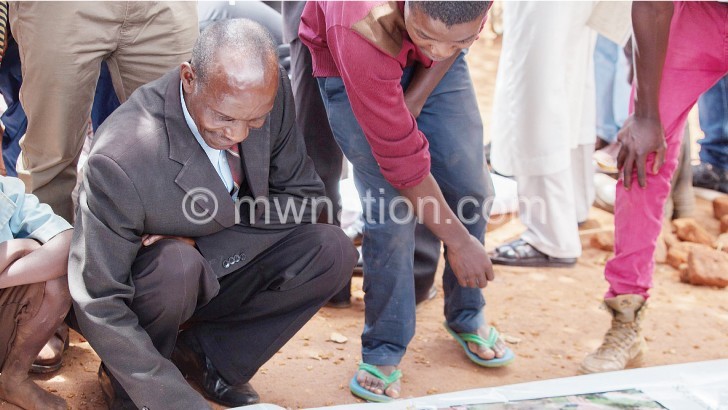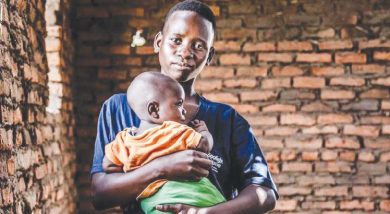Drones fly in anti-cholera raid
Gazing at an aerial view of Chigwirizano, a busy trading centre in Lilongwe, Angela Masoambeta figures out why cholera is ravaging the capital.
Her densely populated location is a hotspot of the outbreak which has killed 24 people in 13 districts. Half of the death toll occurred in Lilongwe.
“We are living dangerously,” she says, pinpointing the clustered spot on the image taken by a drone. “Look here, these are heaps of waste and there is no latrine at the market. Most people relieve themselves in the open behind the shops. It’s easy for flies and rainwater to carry cholera germs to the food on sale. Due to a shortage of benches, vendors lay their goods on the ground. This is unhygienic.”

improved sanitation on a drone-generated map
But Masoambeta, who is startled by cholera attacks, describes a familiar sight in the country which has treated 764 cholera cases.
Fascinatingly, United Nations Children Fund (Unicef) and its partners at the Centre for Development Communication (CDC) are flying the drones to capture bird-eye views to help the community visualise the breeding grounds of bacteria that causes the sanitation-related waterborne disease.
Cholera spreads by ingesting contaminated water or food. It kills within hours if not treated, but is easy to prevent.
According to public health officials, using safe water and practising good hygiene are a cocksure way to prevent the waterborne disease associated with poor sanitation.
“We need innovative ways to deal with some of the challenges we encounter in our work to improve the lives of children,” says Unicef deputy director Mark Harwood.
Since 1964, the United Nations agency has been working with government to uphold the rights, well-being and survival of children.
“Women and children are the most affected by sanitation-related diseases since they spend time at home. Saving them is our mandate. So we are using new ways like drones to locate areas that are prone to the cholera outbreak and to clean them up,” says Harwood.
As the drones take off, Lilongwe University of Agriculture and Natural Resources students venture into the crammed settlement to assist residents understand the preventive measures and dangers of cholera.
When the unmanned aerial vehicles touch down, CDC technicians retrieve images mapping the breakdown in water, sanitation and hygiene services that hide in plain sight.
Circling the map, Chigwirizano residents gleefully spot their streets, homes, churches, schools, shops and other landmarks.
But Frederick Magombo is bothered by unhygienic conditions at the bustling market where meat, vegetables, tubers, flour, fruits and other foodstuffs are sold in the open.
There is no safe water and hundreds of sellers and buyers rely on a shallow well nearby to wash and prepare edible goods on sale.
Farcically, one household has constructed a latrine too close to a neighbour’s open-air kitchen.
“It looks like people just decide to construct a latrine wherever they want as long as they have land. How come this toilet is facing a neighbour’s cooking zone,” asks Magombo as he places a finger on the structure under discussion.
He wants the city council to spell out and uphold dos and don’ts to reduce the shocking spectacle as rapid urbanisation and population pressure leaves low-income households with no land for latrines.
“I think authorities can use this image in allocating plots to ensure everyone has enough space for a latrine,” he says.
The images from the sky do not only help the people clearly visualise sticky points and reflect on the cholera burden.
They also offer critical talking points that persuade the locals to start doing something about unsanitary conditions in their midst.
Chigwirizano and Likuni residents easily resolved to petition Lilongwe City Council to provide safe water, sanitary toilets and clean-ups in the murcky markets.
They wonder why they do not have these basics when they pay market fees daily.
They also called for a quick end to open defaecation, requesting every family to own and use a clean latrine, bin and rubbish pit at all times.
“We cannot continue living this way. We need to kill this cholera outbreak before it kills us,” says Masoambeta.
Minister of Health Atupele Muluzi has a word for all Malawians.
“Preventing cholera is simple. Use safe water and observe basic hygiene.”
But cholera is a constant emergency in the country, especially in Karonga on the shoreline of Lake Malawi, the southwestern border district of Mwanza and the Lower Shire Valley region of Chikwawa and Nsanje.
The last spate in Lilongwe happened seven years ago.
Madalitso Nkhata, who is responsible for disease surveillance and response at Lilongwe District Health Office, reckons the drone images could be instrumental in getting to the bottom of the outbreak.
“We are closely monitoring the situation and investigating the probable source of infection for individual cases,” he says.n





